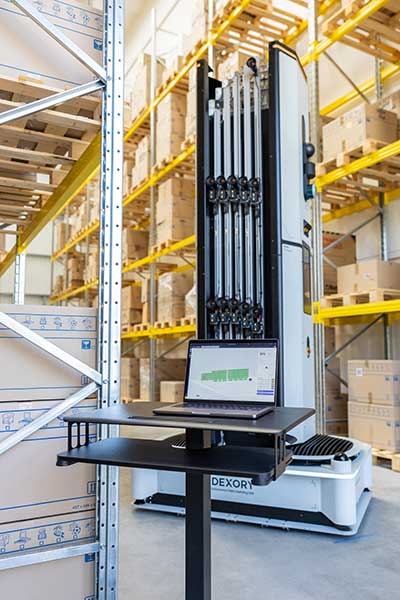Logistics leaders must embrace digital transformation now to stay competitive as global supply chain pressures intensify.
By Andrei Danescu, CEO and Co-Founder, Dexory
Once considered a back-end, manual function, logistics has quickly emerged as a front line for innovation and reinvention. As supply chains buckle under the weight of rising customer expectations, labor shortages, and global disruptions, logistics leaders are waking up to a new reality: traditional operations simply won’t cut it anymore. Digital transformation in logistics is no longer a future goal, it’s a competitive necessity.
At its core, digital transformation is about embedding technology into every layer of operations to boost speed, accuracy, and adaptability. In logistics, this often includes automation to replace repetitive tasks, AI-powered forecasting, and real-time scanning that gives teams a live view of inventory movement.
Recent developments in AI and robotics are accelerating this shift. In the U.S., companies like Amazon and Walmart are racing to deploy agentic AI and robotic systems to improve warehouse responsiveness and customer loyalty. Amazon, for instance, plans to give its logistics operations a significant AI upgrade, aiming to cut delivery times and reduce costs through predictive routing and autonomous sorting.
Meanwhile, many startups are raising millions to develop AI for the logistics industry- a signal that VC money is flowing heavily into this space. In fact, North America accounted for more than 60% of global VC investment in AI in 2024, despite broader geopolitical tensions and regulatory uncertainty. These investments underscore the market’s belief in the transformative power of AI across industries, especially logistics.
And yet, most supply chain organizations are behind. According to Gartner, only 23% of supply chain organizations have a formal AI strategy in place, highlighting a massive gap between opportunity and action.

To bridge that gap, logistics leaders need more than buzzwords, they need a roadmap. Data visibility remains foundational. Real-time insights from shelf scanners and mobile robotics allow teams to spot issues early and optimize in the moment, not after the fact.
Automation doesn’t have to mean disruption. Today’s technologies from autonomous mobile robots (AMRs) to intelligent conveyor systems can be integrated into existing workflows. Scalability is essential. The pressure of peak seasons or geopolitical shifts demands systems that can adapt. Cloud-native platforms and subscription-based models give logistics teams the flexibility to expand capacity on demand, with minimal capital risk.
But technology alone isn’t enough. Change management is where transformation succeeds or fails. Leaders must invest in frontline training, communication, and cultural buy-in. The most successful transformations pair cutting-edge tools with people-first strategies.
Transformation doesn’t need to be massive to start. It can and should begin with a clear understanding of the current state. This means conducting floor-level audits, mapping pain points, and listening to staff.
Once that’s done, define specific, measurable goals: reduce outbound errors by 30%, cut cycle count time by 70%, or eliminate manual scanning in one zone. With clear outcomes, it’s easier to evaluate tools and partners.
Start small. A single pilot site is enough to test and iterate. Recent implementations show how quickly these changes pay off. For instance, companies that integrated real-time scanning tools now complete inventory audits in hours rather than days, a shift that was once unthinkable.
The logistics sector is already seeing what’s possible. Robotics competitions are heating up between the U.S. and China, with both sides investing heavily in next-gen automation to claim dominance in the global supply chain. China, in particular, is leaning into AI to optimize every link of its logistics network, giving it a growing edge in cost and speed.
In response, U.S. logistics companies are under pressure to modernize quickly, and the AI advantage is rapidly shifting the global playing field. Falling behind doesn’t just mean inefficiency, it means lost business and eroded market share.
Transformation isn’t a project with a finish line, it’s a mindset. The companies that lead with purpose, invest in people, and take action today are the ones that will shape tomorrow’s supply chains. Digital tools are ready, the capital is flowing, the competitive pressure is mounting. For logistics leaders, the moment to act is now.

About the Author:
Andrei Danescu is the CEO and co-founder of Dexory, a London-based company specializing in autonomous robotics and AI solutions within the warehousing and logistics industry. With a deep passion for engineering and a background in Systems Engineering and Autonomous Technology, he built his first robot in 2004. Andrei is always on the lookout for new ways to introduce revolutionary autonomous robots into the world.
Read more from the author:
Warehousing’s Future: Adopting Robotics and Automation | Industry Today, April 3, 2025
Redefining industries with robotics and AI | Robotics Tomorrow, February 11, 2025
In this episode, I sat down with Beejan Giga, Director | Partner and Caleb Emerson, Senior Results Manager at Carpedia International. We discussed the insights behind their recent Industry Today article, “Thinking Three Moves Ahead” and together we explored how manufacturers can plan more strategically, align with their suppliers, and build the operational discipline needed to support intentional, sustainable growth. It was a conversation packed with practical perspectives on navigating a fast-changing industry landscape.